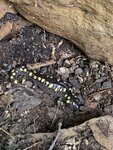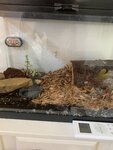Cam_Mears
New member
I recently wild caught a fairly large 4-5 inch Spotted Salamander (Who I named Anthony), and so far he has just been buried under the substrate that we have for him. This is my first amphibian that I have had as a pet, but so far I feel as though I’ve done a good job with his terrarium set up. As spotted Salamanders are terrestrial, I have set up Anthony’s cage up where he has a 10 Gal Terrarium with about 3 inches of organic potting soil (Chemical free) and then another inch of coconut husk substrate on top of that. As for hides, I included a rock cave as well as a half hollowed log for him to go under. The only problem I’ve had is that, I’ve had Anthony for about 3 days now and I’ve been trying desperately to get him to eat/even just open his mouth. However, it’s to no avail. I’ve been hearing more and more stuff about Wild caught specimens sometimes refusing to eat so I’m very confused, what should I do??? I’ve been trying to feed him live night crawlers as well as freeze dried crickets but he won’t even consider either. Also, I’m not sure if this is normal or if it’s lethargic but he will just burrow far down into the substrate and not move for literally entire days!! Just concerned about him. His Terrarium temp is a cool 60 degrees with 70% Humidity and I’ve made sure to mist him daily!! Any help would be GREATLY appreciated!



